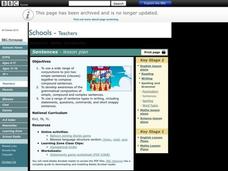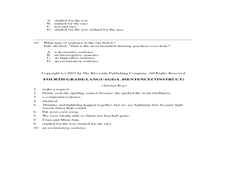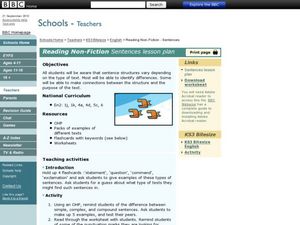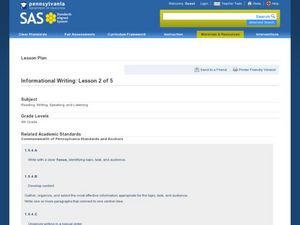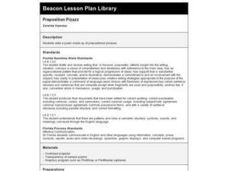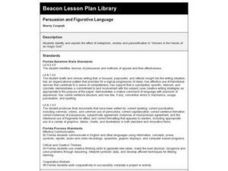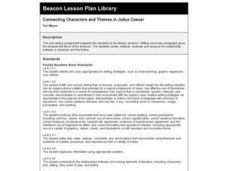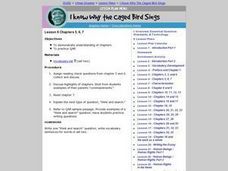Curated OER
Kinds of Sentences by Function Practice
In this kinds of sentences worksheet, students study examples of declarative, interrogative, imperative and exclamatory sentences. Students read ten sentences and tell what type they are and put in the ending punctuation.
Curated OER
Sentences
Students create different types of sentences. In this sentence writing lesson, students use various types of sentences to make writing interesting. Students play online games and use the interactive whiteboard to practice.
Curated OER
Types of Sentences
In this language arts worksheet, learners practice their skills in writing and placing punctuation marks for exclamatory, declarative, imperative, and interrogative sentences. Students complete 16 problems, and an answer key is provided....
Curated OER
Sentence Stucture
For this analyzing sentences worksheet, 4th graders identify purpose, combining, types, and grammar. Students answer 10 questions.
Curated OER
Reading Non-Fiction Sentences
Students identify differences in types of sentences. In this sentence structure lesson, students discuss the different ways sentences are written according to their intended audience. Students create different types sentences...
Curated OER
Active and Passive Voice: Finding Examples Online
Incorporate technological fluency with a search for examples of active and passive voice in online resources. Discuss how use of active or passive voice influences mood or tone and contributes to author's purpose. List of...
Curated OER
Persuasion and Parallel Structure
Discuss the definition of parallel structure with your high school class. In small groups, they read a section of "The Declaration of Independence" to identify examples of parallel structure. Each learner writes an essay explaining the...
Pennsylvania Department of Education
Informational Writing: Lesson 2 of 5
Introduce expository writing to your elementary learners. Young authors write a three-paragraph informational paper using the steps of the writing process. They follow guided lessons to experience each of five steps. Included are tons of...
Curated OER
Four Kinds of Sentences - Fun Review
Fourth graders review for the Four Kinds of Sentences.
Curated OER
The Scoop on Summer
Third graders write a noun that names a place they spent their summer vacation, a verb telling one activity they did, and use those words to write a complete sentence. Finally, they use an ice cream cone graphic organizer as a guide to...
Curated OER
Teacher of the Year
Now is the time to identify the great teachers in your school! Discuss the characteristics of persuasive writing and analyze an example. Then, each pupil chooses a teacher who they feel should be named teacher of the year. They plan and...
Curated OER
I'm the Teacher
First graders simulate being the teacher and giving P.E. commands to the class. They each write a sentence and take turns reading their sentence to the class, and after each sentence has been read the class performs the activity...
Curated OER
Simon Says
Second graders play Simon Says. The teacher uses a worksheet imbedded in this lesson which has suggestions for action commands to be used during the game. The intent is for students to focus on the action verbs which are built in to the...
Curated OER
Thinking Syntactically: Using non-print text to faciliate generation of syntax and analysis of tone
Pupils write with a command of the stylistic aspects of composition. They respond to non-print text. Students demonstrate working knowledge of syntactical choices. They construct sentences using descriptive language. Pupils analyze tone...
Curated OER
Preposition Pizazz
Students examine examples of poems and identify the prepositions in them. They write original poems using prepositional phrases and create illustrations to go with them.
Curated OER
Memory of a Kiss
Third graders read, discuss, and memorize the poem "Jenny Kissed Me." as an example of lyrical poetry. They write a letter to Jenny reliving the memory of her kiss from an elderly person's point of view. They illustrate their poems.
Curated OER
Persuasion and Figurative Language
Students study and discuss definitions of metaphor, simile, and personification. In small groups, they read a section of "Sinners in the Hands of an Angry God" and identify those devices. The group presents their examples with the class.
Pennsylvania Department of Education
6 Traits: Word Choice
Students explore language arts by participating in a vocabulary usage activity. In this word choice lesson, students read examples of great word usage in literature and discuss with the class why some words appear stronger than others....
Curated OER
Where No Student Has Gone Before
Middle schoolers create a story about an unknown planet invaded by humans as a pre-reading activity for the novel, A Wrinkle In Time. They discuss good versus evil, and identify examples of the theme good vs. evil in books, film, and...
Curated OER
Connecting Characters and Themes in Julius Caesar
Fourth graders prepare for the literary analysis. They locate, interpret, evaluate and analyze the relationship between a character and the theme. After a lecture/demo, 4th graders write topic and detail sentences, then correctly put...
Curated OER
Negative Imperatives and Idioms
Students identify and use positive and negative imperatives and idioms in written and spoken dialogues, and use irregular verbs in written and spoken sentences. They complete various worksheets, re-write dialogues, and complete an...
Curated OER
Negative Imperatives and Idioms
Students identify negative imperatives in sentences. They practice using positive and negative imperatives in their written and spoken dialogue. They complete a worksheet to end the lesson plan.
Curated OER
I Know Why the Caged Bird Sings: Chapters 5, 6, 7
Students read chapters from Maya Angelou's I Know Why the Caged Bird Sings and complete literary response activities. In this chapter analysis lesson, students read chapters 5, 6, and 7 and discuss the highlights. Students practice...
Curated OER
Pronunciation of Intonation Patterns
Students in ESOL classes practice communication skills using voice intonation patterns. Using various patterns, they practice sentences with rising and falling intonations. With partners, students read passages orally with emphasis...

